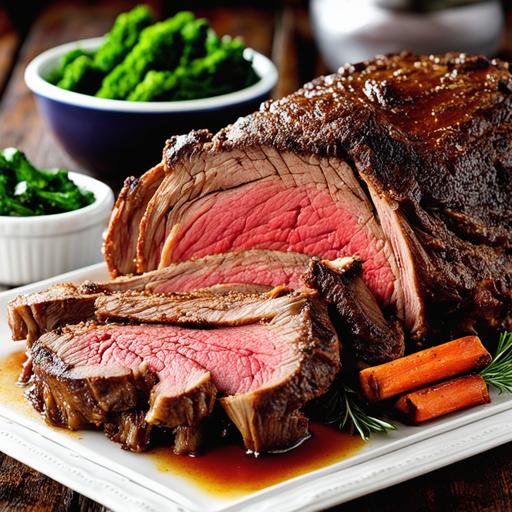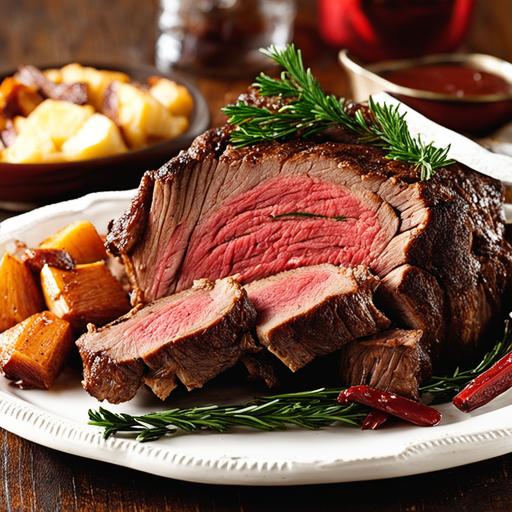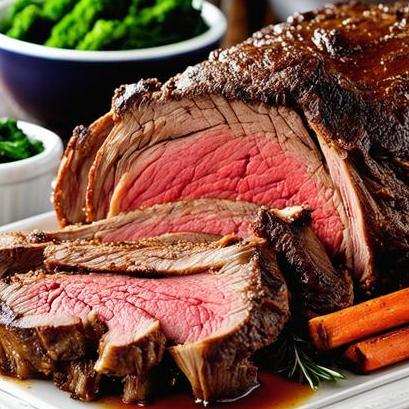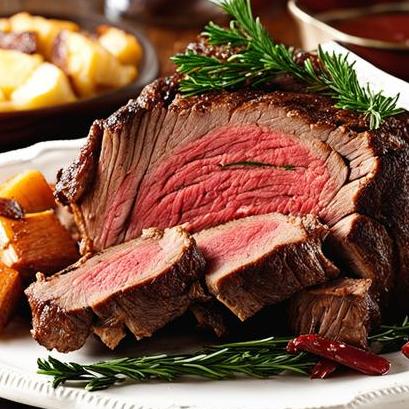- You are here:
- Home »
- Oven Recipes
- » The Perfect Rib Roast Beef Oven Recipe

The Perfect Rib Roast Beef Oven Recipe
If you’re in the mood for a luxurious and indulgent meal, nothing beats a perfectly cooked rib roast beef. This beef cut is the epitome of tenderness, richness, and juiciness. This article will provide you with a comprehensive guide to cooking the perfect rib roast beef in the oven.
Understanding Rib Roast Beef
Rib roast beef, also known as prime rib, is a cut of beef that comes from the rib section of the cow. It is typically cut from ribs six through twelve and includes the spine bones. This cut of meat is highly desirable because of its marbling, which makes it tender, juicy, and full of flavor.
Selecting and Cleaning Rib Roast Beef
When selecting a rib roast beef, look for a well-marbled cut with a bright red color. Avoid any meat that has brown spots or a grayish tint. You can also ask your butcher for a bone-in or boneless cut depending on your preference.
Before cooking, rinse the meat with cold water and pat it dry with a paper towel. This step removes any debris or bacteria that may have accumulated during transport or storage.
Preparing Rib Roast Beef

To prepare the rib roast beef, you will need to season it with your preferred herbs and spices. A classic rub for prime rib beef includes garlic, rosemary, thyme, olive oil, salt, and pepper.
Once you have seasoned the meat, place it in a roasting pan with the fat side up. The fat will melt and infuse the meat with flavor and moisture.
Cooking Rib Roast Beef in the Oven

When it comes to cooking rib roast beef, you want to aim for a tender and juicy medium-rare to medium level of doneness. Cooking time and temperature will depend on the size of the roast and your oven.
Preheat your oven to 450°F. Roast the beef at this temperature for the first 15 minutes to create a sear. After this time, reduce the heat to 325°F and continue cooking for 15 to 17 minutes per pound. Use a meat thermometer to monitor the internal temperature, which should reach 135°F for medium-rare or 145°F for medium.
Tips for Cooking the Perfect Rib Roast Beef

-
Allow the meat to come to room temperature before cooking.
-
Use a meat thermometer to avoid overcooking or undercooking.
-
Let the cooked meat rest for at least 15 minutes before slicing to allow the juices to redistribute back into the meat.
-
Cut the meat against the grain to ensure tender and juicy slices.
Variations of Rib Roast Beef

If you’re feeling adventurous, you can try different seasonings or cooking methods to add variety to your classic rib roast beef. Here are a few suggestions:
-
Santa Maria-style rub, which includes garlic powder, onion powder, paprika, salt, and pepper.
-
Crusted with herbs and breadcrumbs for a crunchier texture.
-
Cooked sous vide for precise temperature control and ultimate tenderness.
Overcooking or Undercooking
Overcooking rib roast beef can lead to dry and tough meat. On the other hand, undercooking can result in raw meat that may pose health risks. Using a meat thermometer is the best way to ensure that you achieve the desired level of doneness while avoiding overcooked or undercooked meat.
Rib Roast Beef Oven Recipe
Here is a classic rib roast beef oven recipe that you can try at home:
Ingredients:
-
1 (5 to 6 pounds) bone-in rib roast beef
-
2 tablespoons minced garlic
-
2 tablespoons chopped fresh rosemary leaves
-
2 tablespoons chopped fresh thyme leaves
-
2 tablespoons olive oil
-
Kosher salt and freshly ground black pepper to taste
Instructions:
-
Preheat the oven to 450°F.
-
In a small bowl, mix together garlic, rosemary, thyme, olive oil, salt, and pepper.
-
Rub the mixture all over the beef.
-
Place the beef in a roasting pan with the fat side up.
-
Roast the beef at 450°F for 15 minutes to sear.
-
After 15 minutes, reduce the heat to 325°F and continue cooking for 15 to 17 minutes per pound.
-
Use a meat thermometer to monitor the internal temperature, which should reach 135°F for medium-rare or 145°F for medium.
-
Remove the beef from the oven and let it rest for at least 15 minutes before slicing.
Enjoy your perfectly cooked rib roast beef with your favorite sides and a glass of red wine!
Conclusion
Cooking rib roast beef in the oven doesn’t have to be intimidating. With a little knowledge about selecting, cleaning, preparing, and cooking the meat, you can achieve a tender, juicy, and flavorful meal that will impress your guests or family. Remember to use a meat thermometer, let the meat rest before slicing, and don’t be afraid to try different seasonings or cooking methods to add variety to your classic rib roast beef.
Sources
FAQS On Rib Roast Beef Oven Recipe
What Is A Rib Roast Beef?
A rib roast beef, also known as prime rib or standing rib roast, is a large cut of beef taken from the rib section of the cow. It is known for its tenderness, marbling, and rich flavor, making it a popular choice for special occasions and holiday meals.
How Do I Choose The Right Rib Roast Beef For My Oven Recipe?
When selecting a rib roast beef, look for one with a good amount of fat marbling throughout the meat, as this provides both flavor and tenderness. It is recommended to choose a roast that has at least three ribs, which can usually serve around 6-8 people. Additionally, opt for USDA Prime or Choice grade beef for the best quality.
What Are The Steps To Preparing A Rib Roast Beef In The Oven?
Before cooking, it is advised to bring the rib roast beef to room temperature for about 1-2 hours. Preheat your oven to a high temperature, around 450°F (230°C). Place the roast on a rack in a roasting pan, fat side up, and season it generously with salt, pepper, and any additional herbs or spices you prefer. Insert a meat thermometer into the thickest part of the meat, and roast it at the high temperature for about 15-20 minutes to sear and brown the outside. Then, reduce the oven temperature to around 325°F (160°C) and continue roasting until the desired internal temperature is reached.
What Is The Recommended Internal Temperature For A Perfectly Cooked Rib Roast Beef?
The internal temperature is an essential factor in determining the doneness of the rib roast beef. For a medium-rare roast, which is the most popular, the recommended internal temperature is around 135°F (57°C). This will result in a pink and juicy center. If you prefer a medium or well-done roast, aim for internal temperatures of 145°F (63°C) and 160°F (71°C), respectively. Remember to remove the roast from the oven a few degrees before reaching the desired temperature, as it will continue to cook while resting.
How Long Should A Rib Roast Beef Rest After Cooking, And Why Is Resting Important?
Resting the rib roast beef is crucial to ensure a flavorful and juicy result. Once the roast is cooked to your desired internal temperature, remove it from the oven and tent it loosely with aluminum foil. Let it rest for about 15-20 minutes before carving. Resting allows the meat to reabsorb its juices, resulting in a more tender and succulent roast. Moreover, the resting period makes it easier to carve the meat without losing its moisture.



